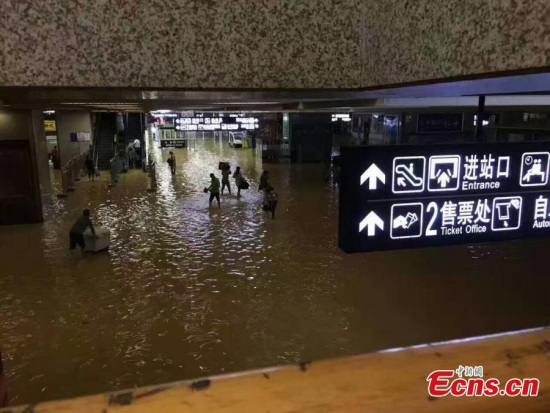
A subway station floods after rain in Wuhan City, the capital of Central China's Hubei Province, July 6, 2016. Several stations in the city's metro line were closed following the torrents. The city has issued a red alert due to the rainstorm, the highest in China's four-color warning system. (Photo provided to China News Service)
China wrestles with the dual challenges of water scarcity and urban flooding -- problems that have been magnified by this summer's heavy rainfall.
To address the flooding, the country is building "sponge cities" to absorb excess water through upgraded sewer systems, filtration pools, wetlands, and permeable public spaces.
Pingxiang City in east China's Jiangxi Province was chosen by the central government as one of 16 pilot cities for the "sponge city" project in April 2015.
On June 14, the city experienced one of its heaviest rainfall of this year, putting its new "sponge" facilities to the test.
The city's Jinluofeng Park was once among the spots more vulnerable to flooding. After the recent rain, however, the park was free from waterlogging thanks to water-permeable bricks installed in the ground.
Mr. Li lives nearby and visits the park on a daily basis for exercise. "The park would be covered in ankle-deep water whenever there was a big rain," he said. "Now I can come here to exercise as long as the rain has stopped."
Lai Qing, deputy director of the city's sponge city construction office, said the city has invested about 2.19 billion yuan (327.7 million U. S. dollars) in 24 pilot programs over the past year.
The city also plans to connect its natural filtration facilities, such as creeks, pools and lakes, to build a sponge system to manage and purify rainwater, he said.
Another of the pilot cities, Nanning in south China's Guangxi Zhuang Autonomous Region, is already seeing benefits from the project.
During past rainy seasons, the city's Binhu Square was drenched in water, and the flooding blocked off a major section of the city center.
A project completed last year replaced the square's granite surfaces with a permeable, sandy material, and the square now absorbs, purifies and collects water, which can used to irrigate local vegetation, said Gan Linyi, an employee with the square's management department.
According to a timetable released by the Chinese government in October 2015, 20 percent of China's cities should have modern sewer systems and infrastructure allowing efficient rainwater absorption by 2020, with the number rising to 80 percent by 2030.
Experts said rapid urbanization has led to obstacles.
Li Chuanming, an official with the drainage department of Hefei City in Anhui Province, said that, ideally, 80 percent of rainwater would be absorbed by the ground, with the other 20 percent drained through the sewers.
In reality, the ratio in most Chinese cities is reversed, as much of the surface is covered in nonpermeable concrete and asphalt, he said.
Mr. Wang, an engineer with the water conservation bureau of Anqing City, Anhui Province, said since cities are already designed and built, improving sewer systems, increasing green space and creating permeable road surfaces would come at a huge cost.
"It is important for governments to attract private capital for the project," he said, adding that cities should integrate the program with urban planning and make sure new development does not stand in the way of building sponge facilities.


















































